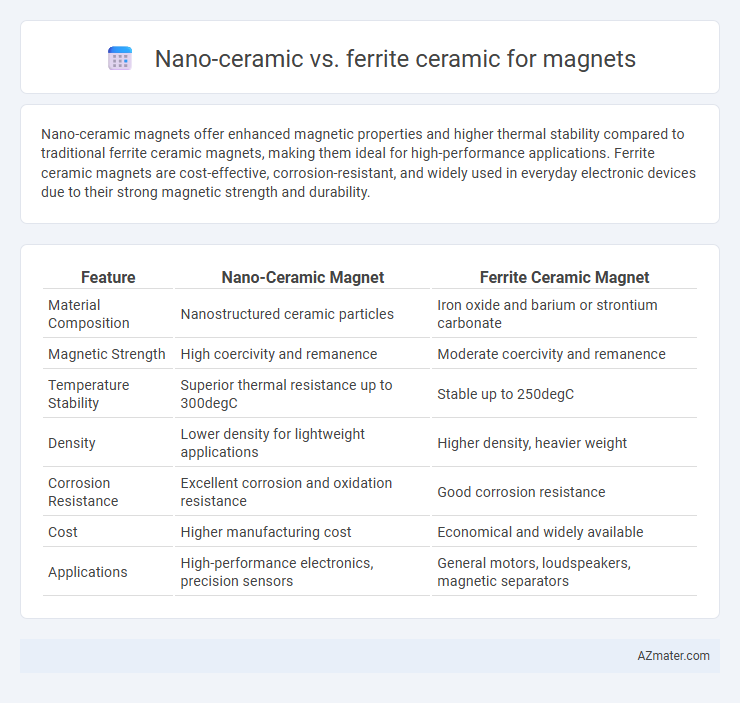Nano-ceramic magnets offer enhanced magnetic properties and higher thermal stability compared to traditional ferrite ceramic magnets, making them ideal for high-performance applications. Ferrite ceramic magnets are cost-effective, corrosion-resistant, and widely used in everyday electronic devices due to their strong magnetic strength and durability.
Table of Comparison
| Feature | Nano-Ceramic Magnet | Ferrite Ceramic Magnet |
|---|---|---|
| Material Composition | Nanostructured ceramic particles | Iron oxide and barium or strontium carbonate |
| Magnetic Strength | High coercivity and remanence | Moderate coercivity and remanence |
| Temperature Stability | Superior thermal resistance up to 300degC | Stable up to 250degC |
| Density | Lower density for lightweight applications | Higher density, heavier weight |
| Corrosion Resistance | Excellent corrosion and oxidation resistance | Good corrosion resistance |
| Cost | Higher manufacturing cost | Economical and widely available |
| Applications | High-performance electronics, precision sensors | General motors, loudspeakers, magnetic separators |
Introduction to Magnetic Materials
Nano-ceramic magnets exhibit superior magnetic properties compared to ferrite ceramic magnets due to their smaller grain sizes and enhanced magnetic domain alignment, resulting in higher coercivity and energy product. Ferrite ceramics, primarily composed of iron oxide mixed with barium or strontium carbonate, offer cost-effective and corrosion-resistant solutions but demonstrate lower magnetic strength and temperature stability. Understanding the microstructural differences between these materials is crucial for optimizing their performance in applications such as electric motors, sensors, and memory devices.
Overview of Nano-Ceramic Magnets
Nano-ceramic magnets, composed of finely structured nanocrystalline grains, exhibit superior magnetic properties such as higher coercivity and enhanced remanence compared to traditional ferrite ceramics. Their nano-scale grain size results in improved magnetic flux density and thermal stability, making them ideal for high-performance applications in electronics and automotive industries. Unlike conventional ferrite ceramics, nano-ceramic magnets also offer greater resistance to demagnetization and corrosion, extending their operational lifespan.
What are Ferrite Ceramic Magnets?
Ferrite ceramic magnets, composed primarily of iron oxide and barium or strontium carbonate, are renowned for their high resistance to corrosion and demagnetization, making them ideal for industrial and consumer applications. These magnets exhibit low electrical conductivity and strong magnetic properties, which contribute to their widespread use in electric motors, transformers, and loudspeakers. Compared to nano-ceramic magnets, ferrite ceramics offer cost-effective performance with moderate magnetic strength and excellent temperature stability.
Structural Differences: Nano-Ceramic vs Ferrite Ceramic
Nano-ceramic magnets feature ultra-fine grain structures on the nanometer scale, resulting in enhanced magnetic properties and higher coercivity compared to conventional ferrite ceramics, which possess coarser, micro-scale grain structures. The dense and uniform nano-ceramic microstructure allows for improved magnetic domain alignment and reduced magnetic losses, whereas ferrite ceramics have a more granular and porous composition that limits magnetic performance. Structural differences significantly impact thermal stability and mechanical strength, with nano-ceramics typically exhibiting superior toughness and resistance to cracking relative to the brittle ferrite ceramic counterparts.
Magnetic Properties Comparison
Nano-ceramic magnets exhibit superior magnetic properties compared to ferrite ceramic magnets, featuring higher coercivity and remanence, which result in stronger magnetic fields and better resistance to demagnetization. The fine nano-scale grain structure in nano-ceramics enhances magnetic flux density and energy product (BHmax), enabling more efficient and compact magnet designs. Ferrite ceramics, while cost-effective and corrosion-resistant, typically present lower magnetic strength and higher brittleness, limiting their application in high-performance magnetic devices.
Durability and Longevity
Nano-ceramic magnets exhibit superior durability due to their finer microstructure, which enhances resistance to mechanical wear and thermal degradation compared to ferrite ceramics. Ferrite magnets, while cost-effective, tend to suffer from brittleness and lower resistance to high temperatures, leading to reduced longevity in demanding applications. Advanced nano-ceramic magnets maintain magnetic stability and structural integrity over extended periods, making them ideal for long-term use in harsh environments.
Cost Efficiency and Manufacturing
Nano-ceramic magnets offer superior magnetic properties at a higher production cost due to complex powder processing and sintering techniques. Ferrite ceramic magnets are more cost-efficient, benefiting from abundant raw materials and established mass-production methods that reduce manufacturing expenses. The choice between nano-ceramic and ferrite ceramics often depends on balancing performance needs against budget constraints in magnet manufacturing.
Applications in Modern Technology
Nano-ceramic magnets offer superior magnetic strength, thermal stability, and corrosion resistance, making them ideal for precision electronics, medical devices, and advanced robotics. Ferrite ceramic magnets, valued for cost-effectiveness and strong magnetic properties at high temperatures, dominate in automotive sensors, loudspeakers, and household appliances. The choice between nano-ceramic and ferrite ceramics hinges on performance requirements, environmental conditions, and economic considerations in modern technology applications.
Environmental Impact and Sustainability
Nano-ceramic magnets exhibit higher energy efficiency and longer lifespans, reducing material waste and environmental degradation compared to ferrite ceramic magnets. Ferrite ceramics, while more abundant and less costly, often require energy-intensive manufacturing processes and contain brittle materials that limit recyclability. Selecting nano-ceramic magnets supports sustainability initiatives by minimizing ecological footprint through enhanced performance and extended durability.
Future Trends and Innovations
Nano-ceramic magnets exhibit superior magnetic strength, thermal stability, and corrosion resistance compared to traditional ferrite ceramics, making them a focal point in the development of high-performance electronic devices and electric vehicles. Innovations in nano-ceramic processing techniques, such as advanced grain boundary engineering and doping methods, enhance magnetic properties while reducing production costs and environmental impact. Future trends emphasize integrating nano-ceramic magnets in compact, energy-efficient applications and smart technologies, surpassing ferrite magnets in adaptability and performance.

Infographic: Nano-ceramic vs Ferrite ceramic for Magnet
 azmater.com
azmater.com